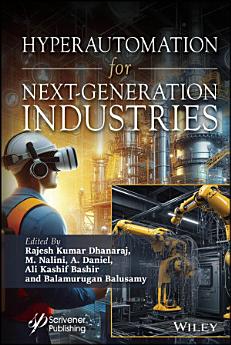Hyperautomation for Next-Generation Industries
Rreth këtij libri elektronik
The use of automation technologies to simplify any and every activity conceivable in a business, allowing repeated operations to operate without manual intervention, is known as hyperautomation. Hyperautomation transforms current and old processes and equipment by utilizing artificial intelligence, machine learning, and robotic process automation. This digital transformation may assist a business in gaining cost and resource efficiency, allowing it to prosper in a more competitive environment. With the advancement of automation technologies, hyperautomation is becoming more prevalent. Companies are shifting their methods to create more human-centered and intelligent workplaces. This change has ushered in a new era for organizations that rely on technology and automation tools to stay competitive. Businesses may move beyond technology’s distinct advantages to genuine digital agility and scale adaptability when all forms of automation operate together in close partnership.
Automation tools must be simple to incorporate into the current technological stack while not requiring too much effort from IT. A platform must be able to plug and play with a wide range of technologies to achieve hyperautomation. The interdependence of automation technologies is a property that is connected to hyperautomation. Hyperautomation saves individuals time and money by reducing errors. Hyperautomation has the potential to create a workplace that is intelligent, adaptable, and capable of making quick, accurate decisions based on data and insights. Model recognition is used to determine what to do next and to optimize processes with the least amount of human engagement possible.
Rreth autorit
Rajesh Kumar Dhanaraj, PhD, is a professor at the School of Computing Science and Engineering at Galgotias University, Greater Noida, India. He has contributed more than 25 books on various technologies, 21 patents, and 53 articles and papers in various refereed journals and international conferences, as well as contributed chapters to books. He is a senior member of the Institute of Electrical and Electronics Engineers and is a member of the Computer Science Teacher Association and International Association of Engineers. He is also an expert advisory panel member of Texas Instruments Inc.
M. Nalini, PhD, is a professor at the Sri Sairam Engineering College, Chennai, Tamil Nadu, India. She has more than 14 years of experience working in teaching and research. Dr. Nalini is the author of more than two books and over 25 international journals and conferences. She has also received invitations to address international conferences as a keynote speaker and session chair and is a member of the Institute of Electrical and Electronics Engineers and a life member of the Indian Society for Technical Education.
A. Daniel, PhD, is an associate professor at the School of Computing Science and Engineering in Galgotias University, Greater Noida, Uttar Pradesh, India. He has published several articles in reputed international journals and is a member of the Institute of Electrical and Electronics Engineers, Association of Computing Machinery, Institute for Educational Research and Publication, International Association of Engineers, and the Computer Science Teachers Association.
Ali Kashif Bashir, PhD, is affiliated with the School of Computing and Mathematics, Manchester Metropolitan University, United Kingdom. Additionally, he is an adjunct professor for the School of Electrical Engineering and Computer Science, National University of Science and Technology, Islamabad, an honorary professor at the School of Information and Communication Engineering, University of Electronics Science and Technology of China, and a chief advisor at the Visual Intelligence Research Center, UESTC. He is the author of over 100 peer-reviewed articles and has served as a chair for several conferences and workshops, delivering several invited and keynote talks.
Balamurugan Balusamy, PhD, is an associate dean to students at Shiv Nadar University at the Delhi-NCR Campus in Noida, India. He has authored/edited more than 80 books, as well as over 200 contributions to international journals and conferences.





